Project Planning Processes
A common misconception is that this phase must be completed before the actual work of the project can begin. This is not true; planning is an activity that continues almost to the very end if the project. In any project, there will always be factors that change as it progresses.
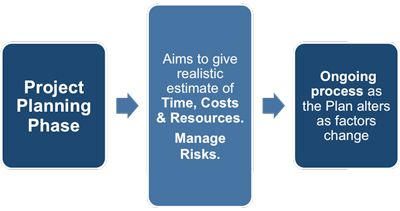 |
In fact, it can be a serious mistake to spend too much time on planning in the early stages of the project as this not only wastes time but can give everyone involved a false impression of how much is really known at this stage. In contrast to the initiation phase (which does have a definite endpoint), it is simply impossible to plan a project and then execute the plan without taking account of changing circumstances.
The main purpose of this phase is to plan time, cost, and resources adequately to estimate the work needed and to effectively manage risk. Initial planning generally consists of:
• Developing the scope statement
• Selecting the planning team
• Identifying deliverables
• Creating the work breakdown structure
• Identifying the activities needed to complete those deliverables
• Sequencing the activities in a logical way
• Estimating the resources needed
• Estimating the time needed
• Estimating the costs
• Developing the schedule
• Developing the budget
• Gaining formal approval to begin
However, it must be understood that as soon as work begins new factors will become apparent, priorities will change, and promised resources will not materialize. If the planning process is not sufficiently flexible to take account of these things then the project will fail.
The need for re-planning should be built in from the beginning of the project and decisions will need to be made regarding:
• How often to re-plan
• How to manage the information that is needed for this re-planning
• How to control changes to the plan
• How to communicate these changes
• How and when to involve stakeholders
Even if the answers to these questions are not clear at the outset, the important thing is to make decisions about them and then modify those decisions as it becomes clear what is and is not working.
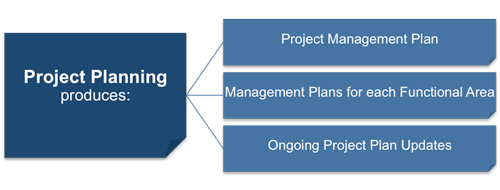 |
The main output of this phase is the project plan and its associated plans for the functional areas of scope, schedule, cost, quality, human resources, communications, risk, and procurement.
According to the PMBOK®, a project plan is defined as:
'A formal, approved document used to guide both project execution and project control. The primary uses of the project plan are to document planning assumptions and decisions, facilitate communication among stakeholders, and document approved scope, cost, and schedule baselines. A project plan may be summarized or detailed.'
The PRINCE2 definition states:
'The Project plan is a statement of how and when a project's objectives are to be achieved, by showing the major products, milestones, activities and resources required on the project.'
The project plan must also describe the execution, management, and control of the project and typically covers the following areas:
• Scope Management
• Requirements Management
• Schedule Management
• Financial Management
• Quality Management
• Resource Management
• Communications Management
• Project Change Management
• Risk Management
• Procurement Management
The emphasis of the planning phase is to develop an understanding of how the project will be executed and a plan for acquiring the resources needed to execute it. Although much of the planning activity takes place during the planning phase, it is important to remember that the project plan will continue to be adjusted to respond to new challenges and opportunities.
The iterative nature of planning is essential because projects follow an uncharted path where new information is continually becoming available as the project progresses. Part of the skill of project management is knowing how much time and effort to put into each stage of the planning exercise.
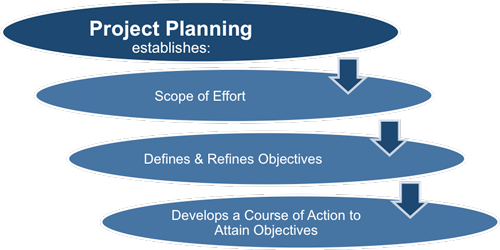 |
The problems created by too little planning are obvious: there will be insufficient information to make valid estimates of time and cost, and the project team may become disillusioned with the apparent lack of direction. On the other hand, if too much planning is done then this can slow the project down (often referred to as 'paralysis by analysis') and the project team may find that the plans are simply unrealistic because they are based on unfounded assumptions.
People new to project management are often uncomfortable with the evolutionary approach to the planning process, which involves defining areas in more detail as and when the necessary information becomes available. However, this is the only way to proceed if there is any degree of complexity involved.
This process is known as 'rolling wave planning' and allows you to plan the project in a series of 'waves,' adding details as you know more. This means that you will have greater definition and details on those work packages required in the near future, and be able to elaborate on those further into the future as details become more clearly known.
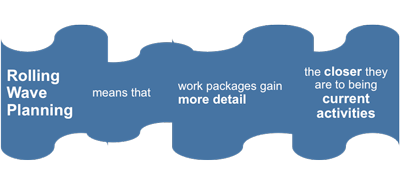 |
This is referred to as 'progressive elaboration,' where work package requirements become more refined and detailed over time, and is particularly useful in projects of high uncertainty - for example, in software development or R&D projects, where the project goal is known, but the final deliverable may change somewhat as the project progresses.
Attempting to create detailed task-oriented plans for project teams in these types of environment is likely to lead to plans that are abandoned soon after being published, and a great deal of time spent endlessly re-planning rather than actually managing the project.
Unfortunately many IT projects undertake the bulk of their planning too early in the life cycle, when little concrete data is known about the problem domain, business environment, or how the team will work together. Rolling wave planning is rarely used in the construction industry, where lack of detail in initial plans may cause huge expense later.
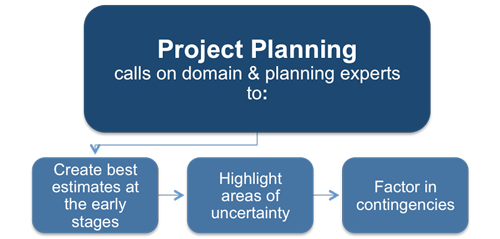 |
Even though a complete set of plans cannot usually be developed ahead of the formal start of the project, high-level plans do need to be produced to define the overall size, cost, and duration. These are necessary in order to seek the formal approval required for their initiation. This raises the question, 'How can projects be quantified and approved ahead of a detailed understanding of the resource and cost implications?'
This question has no simple answer. However, the planning process should call upon both planning and domain experts in defining the overall size and cost of the project. It should be recognized that best estimates often have to be used in the early stages of planning, but that areas of uncertainty should not be 'glossed over.' In fact, these areas should be highlighted, so that contingencies can be factored in and the planning of these areas can be refined at a later date.
Some of the decisions that will need to be made include:
• How detailed to make the plan
• How far ahead to plan
• How to involve stakeholders in planning
• How to keep the planning process streamlined
• How to manage the data that is being fed back into the planning process
• How to determine the quality and reliability of this information
• How often to re-plan
• How to administer changes to the plan
• How to minimize the effect of changes on work in progress
The project plan is the major output from the planning process. Developing it is the process of documenting the actions necessary to define, prepare, integrate, and coordinate all subsidiary plans. It represents the primary source of information for how the project will be planned, executed, monitored and controlled, and closed.
 |
The project plan and other documents developed from the planning process group cover all aspects of the project scope, schedule, costs, quality, communications, risk, and procurements. Updates from approved changes during the project may significantly impact parts of this document and will provide greater precision with respect to schedule costs and resource requirements.
A working version will need to be released to the project team at some point so that they know what they are supposed to be doing. This plan should pass the following tests.
• Does it include all known major project tasks?
• Is it in sufficient detail to generate work packages?
• Are all activities in their chronological sequence?
• Are the task interdependencies clear?
• Is it easy to understand?
• Does it make clear to everyone involved what they are expected to do?
• Can everyone see what is being done in the next few weeks?
• Does it have broad acceptance amongst the stakeholders?
• Is it flexible and able to take account of changes?
• Are the milestones shown?
• Are the duration estimates achievable?
• Are urgent and high-priority tasks clearly highlighted?
• Can it be used to check day-to-day progress?
• Does it take account of the available resources?
As a project manager one of the most comprehensive and important documents you will have to produce is the project management plan (often referred to as the project plan). This plan contains all the key information and plans that you require to manage, monitor and implement your project successfully.
1. Executive Summary - Provides an overview of the management approach to the whole project. This is where you state who makes up the project team, along with their skills, role and level of authority. You also need to describe which departments, divisions and suppliers will provide the project's required resources. This also needs to state at a high-level any constraints or limitations associated with these resources.
2. Project Scope - details exactly what your project is, whom you need to communicate with to gain approval and sign-off for your project to. The objective of this section is to ensure that everyone involved has been thoroughly communicated with and has a comprehensive understanding of what your project means to them and the organization. Within this section you will document and collate the 'end users' requirements and gain agreement for what they expect as a final product. The project charter provides a broad overview to which you need to add a stakeholder register and once the scope is verified demonstrates their acceptance of the project deliverables.
3. Timeframe Management Plan - provides the feasible delivery dates for each phase of your project and the final completion date. The milestones of your project are described in this section along with any known constraints. Controlling this area will be critical to the success of your project in a timely and cost effective manner.
4. Cost Management Plan - is the section where you provide detailed figures on all the estimated costs of your project. As project manager you will outline how you will manage, report and control the projects budget so that it achieves the promised return on the organization's investment. A common technique used in this area is Earned Value Management (EVM) where your forecast of expenditure is compared to the projects actual costs.
5. Quality Plan - defines the quality standards the project must meet and how you will mange the compliance of deliverables. When a project fails to meet its quality requirements there are serious repercussions on the delivery and acceptance of the project, so it is a key area to define appropriately.
6. Human Resources Plan - defines the core people, plus their skills and expertise that is required for your project. These core individuals will be committed to the project for its entirety and details of other resources required throughout the project are described in this section. You will outline how you will acquire, develop and manage all your project resources.
7. Change Management Plan - is a critical aspect of your project because this is where you define 'who' has the authority to approve change requests and how those change requests will be managed and approved. As more and more organizations become project based entities it is likely that you will need to liaise with a 'Change Control Board' or 'CCB' that manages, records and monitors this aspect of projects.
8. Communications Plan - forms the foundation of how you as project manager will identify and manage the various working relationships needed for your project. An essential aspect is to identify your stakeholders and their level of interest in the project so that you can properly manage their expectations. You will also define how (email, memo, meetings etc.) and when you will communicate with them to ensure they are kept informed of progress.
9. Risk Plan - within this section of your project plan you describe how you will identify, assess and manage risks. For each risk you will assign a level of seriousness, probability and likely impact of each risk, which will be documented in your Risk Breakdown Structure (RBS). As your project progresses the risk register and planned responses will be updated, as risks are no longer relevant and new ones occur.
10. Supplier Management Plan - identifies the products, services and resources that need to be acquired or purchased from outside of the project team. It will include the timeframe for each resource and the quoting and management processes attached to this procurement.
It may also include the following:
a) Life cycle selected for the project and the processes that will be applied to each phase.
b) Details of the tailoring decisions specified by the project management team as follows:
• Project management processes selected by the project management team,
• Level of implementation for each selected process,
• Descriptions of the tools and techniques to be used for accomplishing those processes,
• Description of how the selected processes will be used to manage the specific project.
c) Description of how work will be executed to accomplish the project objectives.
d) Change management plan that documents how changes will be monitored and controlled.
e) Configuration management plan that documents how configuration management will be performed.
f) Description of how the integrity of the project baselines will be maintained.
g) Requirements and techniques for communication among stakeholders.
h) Key management reviews for content, the extent of, and timing to address, open issues and pending decisions.
You may also be interested in:
Project Management Processes | Project Initiation Processes | Project Planning Processes | Project Executing Processes | Project Monitoring and Controlling Processes | Project Change Control Processes | Project Closure Processes.
|
|


